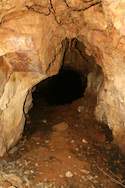Target: Earth

In the 1950s, a book called ‘Target: Earth’ was published in which the authors suggested that the dinosaurs became extinct as the result of a large meteorite impact.
In 1959, Robert Dietz examined several ‘crypto-explosion’ sites and identified shattercones for the first time.
Dietz also predicted that shattercones would be found in the Vredefort Dome, which a South African geologist duly described a year later.
Dietz went on to identify shattercones in the large Sudbury Structure in Canada. Throughout the 50s, a series of laboratory experiments in which projectiles where hurled at targets to simulate collisions added further weight to the impact argument.
Nuclear testing also played a part, when scientists found that the energy released by powerful bombs melted the surrounding rocks and created shock metamorphics, similar to those found in craters.
The Astro-Geologist
In the 1960s, men crept into space and began taking satellite images of the earth-moon system. This broadened the minds of scientists and the general public alike. At the same time, a pioneering ‘astro-geologist’ named Gene Shoemaker conducted a thorough geological investigation of Meteor Crater.
He then compared the findings with analyses of other known volcanic sites. The significant discrepancies he found finally proved that Meteor Crater had been caused by an impact event and not by volcanism, cryptic or otherwise. He subsequently went on to promote the concept of impact science, suggesting that impact events could cause catastrophic geological changes on Earth, and that impact events were comparatively common in the universe.
Shoemaker also taught the astronauts of the Apollo moon missions about crater structures and told them to keep an eye out for interesting lunar rocks. The rock specimens they brought back from the moon demonstrated similar shock deformations to those found on Earth, and helped settle the lunar debate.
Today, Shoemaker is best known as part of the eponymous team that identified the comet Shoemaker-Levy 9, which crashed into the atmosphere of Jupiter in 1994, with spectacular results. Gene Shoemaker died in 1997 and his ashes were sent to the moon in a Lunar Prospector probe. Unfortunately, the probe crashed into the moon’s surface, which would have pleased the old man immensely.